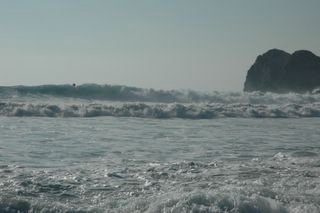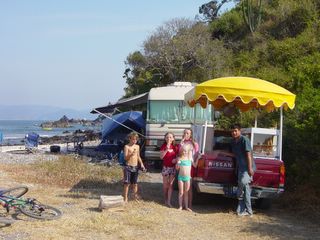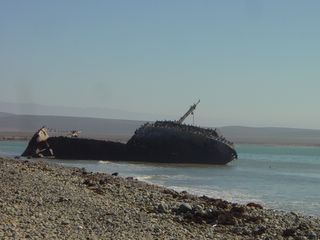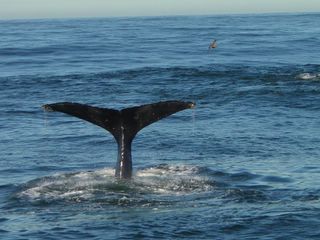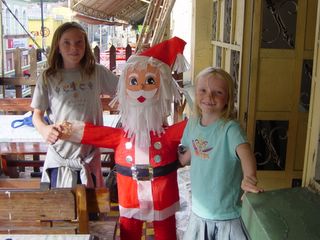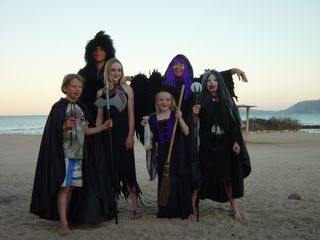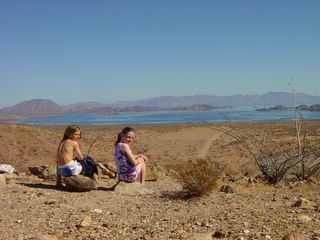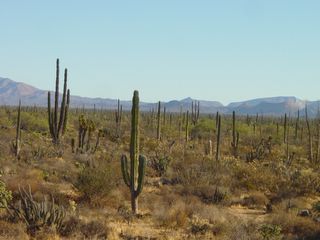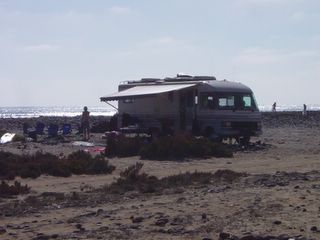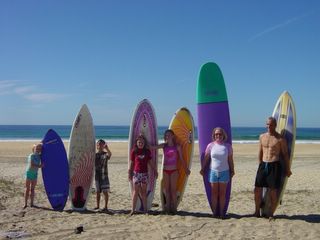Saturday, December 31, 2005
Friday, December 23, 2005
Tuesday, December 13, 2005
First Blog from Mexico
This is our first go at this so bear with us/ switch off if it all gets too excruciating. After months of struggling to get our internet provider in the UK to accept photo images on our emails home we have given up and this is an attempt at an alternative route. Lets see if it works!!
We're in a beautiful area just to the north of Puerto Vallarta (P.V to locals), with a swell forecast to hit some time in the next 24 hours. In fact as I write this I can hear waves beginning to pound the beach, bodes well for the morning.
Speaking of which it IS actually now the morning, 4.36 in the morning to be precise. The combination of rumbling surf noises, cockerels hard at it nearby and a post Margarita wave of nausea (too much detail?) have forced me out of bed. Still it's not a bad time of day to try and sort this blog out... at last.
We'll try and put a few links to useful/interesting sites on the sidebar. So far the ones I have tried have been blocked. This may be something to do with my technophobiclumsia, or it COULD be because they are US government sites (mainly surf and weather forecasting sites) and therefore blocked. I am suspicious partly because I know that blogs from US servicemen and women in Iraq have been causing some consternation within the US establishment, perhaps their relationship with blogger has become strained. We'll see.
For camping over the next few days we have a number of options to choose from, as we are staying in this area until after christmas. They range from busy and rather touristy satelite villages to the North of P.V., with smart and expensive R.V. parks (full of, well, smart and expensive R.Vs); to spots we have discovered down gravel roads a little further to the North with nothing but turtles and coconuts for company. In between are campsites with limited facilities, fantastic beaches, and a few gunk-holing travellers.
Each have their merits!! The former options score points for the ready availabilty of tacos and cerveza, while internet access and swimming pools are plus points for the kids. The latter for the freedom and uncrowded paradise on offer if you are willing to explore & rough it a bit.
Highlights on the Mainland so far include the wonderful city of Mazatlan, where the ferry from Baja arrived soon after sunrise. We rose from our bunks at dawn to see the mountains of Sinaloa from the top deck of the ferry. It was a stirring experience. Steam and mist hung over the GREEN hillsides beyond the city. A complete contrast to the desert landscape we had left behind in Baja.
Mazatlan itself a chaotic and bustling city with a fantastic market. Piles of meat, fish, fruit and vegetables, woven, carved and sculpted artwork. The kids bicycled around for a bit, particularly up and down the Malecon. Many of the coastal cities we have visited so far have these excellent waterfront pavements, used by families to stroll, chat, bike, skate, long into the balmy evenings and on lazy afternoons.
When the bikes became too terrifying in the chaos of traffic we caught buses, marvelling at the colourful cityscape, the huge variety and ingenuity of stalls and workshops in the commercial streets. How sad it seems that development, and economic prosperity somehow supresses that side of our culture: the side which pushes us to improvise, invent, repair. Our cities and shops at home in the Uk; and certainly those we visited in the States appear very monocultural and rather bland in comparison.
Baja by Bus
Border
Billed as one of the worlds great road journeys, the 1000 odd mile odyssey of the journey down this great peninsular (one of the worlds longest) starts, if you so choose, with the dramatic border crossing at Tijuana, where for the last few miles on American roads occasional glimpses of vast Mexican flags, flying proud in the strong sea breezes which dominate afternoons here, herald your arrival in the border zone.
The build up to this crossing, perhaps more than any other we have yet experienced, was a truly nerve wracking affair: guide books and anecdotal warnings from other campers in the US campsites led us to believe that once out of the comfort zone in America's wealthiest state, we would be running into a difficult time. A gauntlet of corrupt federales, hawkers and hustlers, would out- flank us as we negotiated the potholed and cliff hanging roads to the south of the border, whilst tequila'd truckers tried to mow us down as we rounded every bend.
Not since crossing from Spain into Morocco as nervous, hitch hiking teenagers had we anticipated the abrupt transition from first world comfort into the unknown, with quite such a mixture of feelings: excitement and dread. These great crossings from one world into another are so tangible: the physical distance so short and yet the cultural and economic transition so vast.
Yet this time we were responsible not only for ourselves but for our four young charges. Their welfare, and sense of well being, now the most important motivating factor in our lives. We were therefore, also now approaching a critical psychlogical barrier- the crossing of which could lead to, on the one hand, a treasure trove of experience from which the children could draw strength and understanding for the rest of their lives. On the other hand the possibility of disaster: disease, accident, some violent confrontation, a lifelong aversion to travelling (or worse:surfing!). Sleepless nights at home in Devon, worrying about leaving the life we led there, were replaced in the US by sleepless nights worrying about the life ahead!
In the end the greatest anxiety we have so far experienced was on the US side: trying to change dollars into Pesos; a process that for some reason seemed fraught with difficulty given that this is one of the busiest border crossings in the world. Just driving around the rather seedy commercial district on the US side, looking for a place to park, was the most alarming part of the entire process- every turn threatened to lead us into a forbidden customs zone, or down a street lined with shady looking characters leaning on vehicles laden with goods of all descriptions. Occasionally we'd come to a sign saying “last US exit, no return past this point” as though we were entering some hellish inferno, with no prospect of escape beyond those menacing gates.
The money changers themselves were not inside the smart banks we had seen elsewhere in the States, but dis-organised kiosks selling coke, crisps... and Pesos. It all seemed somehow as though we had already crossed the border.
The moment finally arrived however- we could put it off no longer. We trundled our swaying motorhome down the last few hundred yards to the border itself, laden with surfboards, bikes, camping gear, school books, tools... such food as we thought we could get away with carrying with us; and then suddenly we were through! Swept through as though on a raft on a fast flowing river, the US border guards totally un-interested in our departure and the Mexican officials distractedly flagging down a very smart car ahead of us, driven by a glamourous young woman in dark sunglasses.
Her attention was obviously more interesting than our smelly, swaying old RV with its strapped-on, dangling indicators of an intended family camping expedition. No doubt any experienced border guard would instantly recognise us as a lot of hard work for little return. (A thorough search of our teeming and packed drawers would yield much in children's “found treasures” collections, but little in terms of serious contraband).
The river of traffic flowed on, carrying us with it, and somehow we were bursting clear, down the highway that parralels the border fence, the smooth highway, no sign of the hustlers or traffic cops, no onrush of suicidal truckers, just glorious sunshine, the border fence on one side, the ugly but exciting sprawl of Tijuana on the other. A hint of shanty and then we crested a hill, rounded a corner and there it was- a collective intake of breath greeted the view as the silver blue Pacific appeared before us, stretching endlessly to the South and West, with the promise of warm water, peeling waves, fish tacos and thousands of miles of perfect beaches. In an instant the worries slipped away, the tightly controlled and boxed-in atmosphere of California was replaced by a glorious sense of freedom.
No doubt Tijuana is not, if you do stop and take it in, an area to leave ones luggage unattended. The same of course could be said of any town in any country I have ever visited or lived, not least in little England, but whatever the merits of stopping to imbibe some of its flavour, our goals lay elsewhere- and we had determined to put some distance between ourselves and the creeping development that runs down the coast in this area.
We drove south for a couple of hours, stopping to eat briefly in a small restaurant in Ensenada, before heading out to the coast down a small road which led, according to the map and Mike Parise's excellent Surfer's Guide to Baja, (Bible number one) to an area laced with surf and fishing potential. Puerto San Thomas, and it's namesake Punta was to mark our first departure from the tarmac onto one of Bajas famed “washboard roads”.
The Washboards
The first indication we had been given that such a term even existed had been back in good old Santa Cruz, in the foam mattress shop. We had parked, as in the States one is so often able to do, right outside the shop, the clumsy bulk of our Motor home blocking the entire glass frontage.
The proprietor glanced casually out of his window as he heard our enthusiastic plans for surf exploration south of the border. A knowing smile crossed the calm, tanned face, crows feet lines spreading from the corners of eyes long accustomed to scanning the horizon for that tell tale bump in the glinting surface of the ocean: a face so possesed of experienced wave hunters the world over. “Have you ever heard of washboard roads?” he drawled laconically.
It was as much a statement as a question: as much an expression of encouragement as one of warning. It was as if he had in front of him the very road itself, as if he was back there, behind the wheel, facing the long trek to the promised point, beach, reef. Knowing the hours of bone shaking trauma to come, bouyed only by the prospect of untold joy as a reward for making that trek. Knowing the risks: a washed out arroyo not yet repaired, a wind blown drift of sand, a swamp of axle sucking mud, a triple puncture-or broken suspension, even the possibility at the end of all this of a two week flat spell if none of the other risks materialised.
The washboards themselves are caused by the vehicles which use them, bumping through the dust and stones, creating little bumps along the way. Over time numerous vehicles compact these lumps,wind driven sand and dust adds to them, and water from occasional rains cements them. Drivers attempt to avoid them by driving to one side or another- creating new lumps alongside the original ones and, eventually, a series of parallel lines of lumps perpendicular to the direction of travel, traverse the entire width of the road, sometimes for miles on end.
The effect is to turn the road surface into a continuous series of small speed bumps, one after the other like a train of waves, such as might be seen on the surface of the ocean after the breeze has ended and the crests of the waves have turned into smooth swells, or of course, on an old fashioned washboard. Ranging from one to four inches in wave height, perhaps four to six inches in wavelength, the washboard surface is one that few vehicles can travel over without a severe toll being taken on the vehicle and occupants.
The washboards provide the driver with two choices: speed up and try to fly over the top from crest to crest (risking all in the face of the other hazards these roads throw up: sudden deep holes, wandering cows, large cactus in the way); or going very slowly indeed ( the only option in a large motor home).
The campsites
But the rewards push such concerns into the back of our minds as we think now of the views, from the top of a rise, of that track running off through the desert landscape to the distant ocean, of the twists and turns through the dry arroyo beds with tarantulas, lizards and scorpions scuttling for cover; vultures and frigates wheeling overhead in the clear blue sky. The endless and remarkable forest of 40ft cactus, the beautiful desolation of the place, so untamed by humans, yet the home of ancient cave dwellers for tens of thousands of years.
We think too of the ends of these roads: the last bump, the last rock, dune or corner is negotiated and there, gloriously, before us: the most perfect campsite in the world! Flat sandy clearings worked into the rocky surface of the shoreline by generations of camping surfers provide the nest sites for weary travellers. Here and there clustered around the best vantage points, a few other vehicles with tarpaulins stretched tight from their roofs, mark the territory of other pilgrims to these treasured spots. Signs of semi permenance indicate the established camps of some weeks or months duration: racks of surfboards, cables strung with drying laundry, wetsuits, fishing lines.
Driftwood and rock sculptures, the product of the waiting periods: from end of the light winds and glassy waves of the morning through to dusk, when the relentless, wave spoiling onshore breeze of the afternoon slows fitfully into the darkness of the night; and of course the occasional gaps between swells, short though they seem.
In some places, where the rocky points jut far enough into the pacific to provide some shelter as well as peeling surf, shanty constructions of driftwood and tin near the deepest water entry points place the Mexican fishing camps. Perhaps a few Pangas drawn up on the beach show the launch site. The hard working Pangueros rise like the surfers at first light, launching into the swell before heading out to the favoured fishing spot. The wetsuited surfers clustered around the take-off zone wave to their oilskin clad brothers. The waves are returned: an inextricable bond forged between lovers of this place, this moment. The rising sun, the ocean a heaving glassy calm, the seals conjuring breakfast from the kelp and reef below. Ashore, the late risers cup their hands around mugs of coffee and gaze quietly at the scene of utter peace around them.
Journey South
From Santo Thomas, via mellow, longboardable Punta Camalu we made our way to Punta San Jacinto, the right point made famous by the wrecked freighter in the lineup. On good days you can ride from the outside right around the wreck to the beach hundreds of yards down the shore! For us a mellow swell made for good learning conditions for the kids- and a chance to build up some confidence in the viability of our new found lifestyle.
The main highway, Mex 1, does not hug the Pacific, but leads a merry dance from the Pacific to the Sea of Cortez, back to the Pacific and again to the Cortez side at La Paz. In between, long stretches of immense desert plains and endless ranges of dry mountains lead the traveller inexorably on.
We diverted towards Bahia de Los Angeles on the first of these dips towards the East. (Our time there warranted a blog of it's own so link there if you are interested).
A week of such frivolity was more than enough of a diversion from the main quest however and in dragging ourselves back to the road once more, we were faced with a long stretch of Mex 1 followed by another torturous washboard and mud encrusted adventure; totally unsuitable for the vehicle in which we we were travelling. Our reward? Well, the campsite which, in Baja to date, closest fits with the travelling surfer's dream of perfection. Punta Rosarito, The legendary Wall. Long, perfect, right pointbreak, big and consistent, with occasional lefts to add variety. An inside cove with a good longboard wave, a mellow vibe ashore and in the lineup. Fish in abundance, water just beginning to lose that California current chill. Ahh, now we were beginning to get the hang of this Mexico quest.
Sea of Cortez
Not all of our off-road wanderings led to the Pacific Coast of Baja. In fact the transpeninsular highway, MEX1, wanders from the Pacific side to the Cortez coast, crossing the wild and beautiful desert plains; and the rugged mountain ranges that form the spine of the peninsular. Adopting the same principle on the East coast as we had on the West, we looked for any side roads that might take us to the beach, and sure enough, there were beaches!
The Sea of Cortez had long held a fascination for us, not least because of the wild ravings of a certain Mr. Christopher Swann, reknowned cetacean expert and energetic explorer. Emails from him in recent years offered us a hint of the teeming marine wildlife to be found here. Nevertheless we were un-prepared for the extraordinary abundance we discovered on our first days camped on this coast.
Our first view of the sea as we descended the last few winding kilometers from the desert plateau: completely breathtaking. Islands enclosed the sweeping bay before us. The sea and sky locked in a tremendous argument, so it appeared, as to who could be the bluest. Hardly a breath of wind rippled the surface of the water, so that even at a distance of perhaps six or seven kilometers, it looked like a sheet of silk more than the ruffled, glinting surface one would expect of such a large body of water. Having crossed from a November Pacific, where there is never a dull moment on the surface of the water, this absolute flatness seemed almost artificial, as if in a slightly unrealistic painting.
It certainly looked inviting; and within a few minutes of pulling up at the shore, the children were snorkels-on and under water, trilling with the unbounded joy of finding the water temperature a full 5 or 6 celcius higher than the Pacific, no wetsuit required- at last!
We had stumbled across an excellent fishing camp, guided by the thoroughly researched Camping Baja and the excellent fishing bible Baja Catch. These along with the Surfers Guide have been indispensable companions for the journey (Most dog's ears would be insulted).
A few kilometers along the shoreline from the fishing camp, Bahia de Los Angeles boasts a quiet little Mexican town. A couple of hotels and the few expat. Gringoes dotted around in permenant motorhome-cum-palapas, supplement the income of local fishermen, the ubiquitous Pangueros. By and large however it is an unspoilt, working town, it's just in the most extraordinary location!
With Suzanne's birthday imminent, the children became increasingly anxious that the haul of trick-or-treating swag might be reduced this year, possibly even limited to the festering biscuits left in our own cupboards. We were all delighted therefore, to find that the Mexicans had discovered trick-or treating as well. It wasn't entirely clear whether the herd of children that arrived, well before dark, were only raiding gringos, or whether they were touring town as well, but either way the game was clearly on!
Suzanne of course had managed to conceal a stash of sweeties in case of need, and when our gang saw the sweets dissapearing from under their noses there was a scramble for costumes. We had taken advantage of the pre halloween hysteria in California and stocked up with hats, false teeth, horrid wigs, fake blood etc. and so off they set, sheepish parents in tow, for a tour of the campsite and nearby palapas. What had seemed like a hopeless cause turned into a bonanza in the most unlikely of settings.
And Swanny's wildlife ravings? Well of course it all turned out to be completely true. Within a couple of days we had caght ridiculous numbers of fish, swum with a pod of Whale sharks; and the children had become attuned, and savage enough, to be pulling Octupus from beneath the rocks with their bare hands, before gutting them on the spot with their teeth...think I'm joking?

releasing leatherback turtle hatchlings on the beach, Bahia de Tortugas

Bahia de Tortugas, Nayarit
An emotional experience for all of us, perhaps Tas in particular. We found ourselves here by chance- none of our maps or camping guides had mentioned this place. As we drove down from San Blas towards Puerto Vallarta a sign by the roadside pointed towards Bahia de Tortugas. Tasman's lifelong obsession with all shellbacked creatures means that anything even vaguely related to turtles warrants closer inspection; And a ten kilometer gravel road was nothing to some of the washboards of Baja!
We found ourselves driving through a flood plain, flat and well farmed with fertile soil and shallow wells dug here and there for irrigating the crops, corn, beans and grazing for cattle. As we neared the coast and the soil became more sandy, coconut plantations appeared and soon we were in the thick of a very large grove of palm trees. This was more like a forest than a grove, stretching for several kilometers along the ocean, perhaps a kilometer deep, and our track had now turned to run parrelel with the coast, so we were driving right through this beautiful stand of palms. The afternoon sunlight shone through the fronds above and bathed the entire scene in a flourescent green and gold glow. It was obviously taking us somewhere special, this track.
Eventually we wiggled down to the end of the lane and found that we were not the only ones to have thought this looked like a nice spot. Some very fancy houses appeared in the distance and we feared for a moment that the whole thing might have been privatised. The great thing about Mexico, however, is that NO-ONE can own the beach! So we were able to drive right through the palm trees some distance away from the houses, and park completely free, right on the beach!
This truly was a lovely campsite, we had to position ourselves quite carefully to avoid the considerable risk posed from above (apparently more people are killed by falling coconuts than by sharks); but once safely tucked in, our view was the ocean, our shelter the rustling palm fronds, our floor a carpet of soft grass. As we stepped out of the palms onto the beach we saw that the pristine, palm fringed sand stretched away to the south as far as we could clearly see; and only in the far distance, perhaps six or eight kilometers away did the coast turn again, where the next rocky promotory jutted into the Pacific.
It all seemed pretty idyllic and there only remained a couple of missing pieces for the "nice spot" jigsaw to be complete, and, sure enough this place had it all. Perfect waves were wrapping around the rocky point a few hundred yards up the beach to the North!. A very pretty river ran out into the sea below making for an easy paddle out in the deep water created by it's flow. To cap it all, beach side of the smart houses we had seen when we first arrived, was a small cluster of buildings which to Tas's delight, turned out to be a government sponsored Turtle conservation camp.
Apparently the sea turtle population in this area had become so threatened by the long history of human persecution that the Mexican Government stepped in to try and sort the problem out. They established a number of these camps up and down the coast. The staff patrol the beaches where the turtles nest, at night when the eggs are being laid. Once the mother returns to the sea, her mission accomplished, the eggs are recovered and incubated at the camp. 50 days later they hatch and within a few hours the hatchlings are released into the sea.
By controlling the time of day and the location of the release; and by protecting the eggs in the first place, the percentage of live hatchlings returned to the sea is as high as 90% of the original egg numbers. The result has been a 30% increase in the population of returning adult turtles over the 15 years the programme has been running- an outstanding success given the catastrophic decline in numbers over the prvious two hundred years. Maybe, just maybe, they have acted in time.
We were lucky enough to be here during one of the peak release periods; so one evening, with Meche, the marine biologist in charge, we took trayloads of tiny turtles down to the shoreline and placed them carefully on the sand. Of four hundred hatchlings, newly emerged from their eggs, not a single one set off in the wrong direction! After a puzzled pause, and in dribs and drabs, they set off towards the surf, poor little things! Washed in repeatedly and thrown onto their backs by the surge of the waves, we were kept busy putting them back upright again whilst keeping an eye out for circling vultures, gulls and pelicans.
After half an hour or so, with sand flies biting our ankles and wrists (no insect repellent allowed!), we were watching the stragglers battle their way into the vast ocean. Such tiny creatures in such an awesome space. It was an enormously uplifting experience, but one tinged with sadness at the thought of the struggle ahead. So few of course, would escape predation, pollution, fishing nets and longlines, and eventually return to this beach.
For the next 8 years they would drift and swim around the great circuit of the Pacific currents. Down with the California current to the equator, across with the equatorial drift and north again past melanesia into the Kuro Shio, the Pacific version of the Gulf Stream which shoots past Japan. Eventually, when they are ready, the circuit brings them home, to the very beach from where they departed, even though their only experience of that beach would be the brief struggle from nest to surf line. The level and power of such instinct is beyond our comprehension. The very lucky ones may return annually, after this first long swim, to nest again for up to a hundred years. Remarkable creatures indeed.
Inevitably we holed up here for as long as the water lasted; and with surf every morning, turtles to release in the evening... could probably have spent the entire year here really! But... we're on a mission. Could be we'll never find somewhere as nice again!
